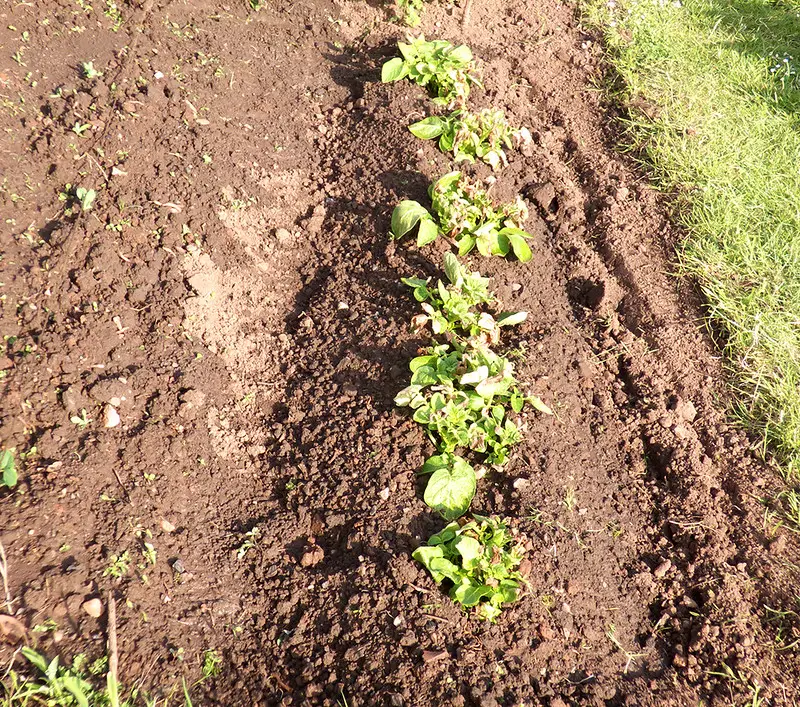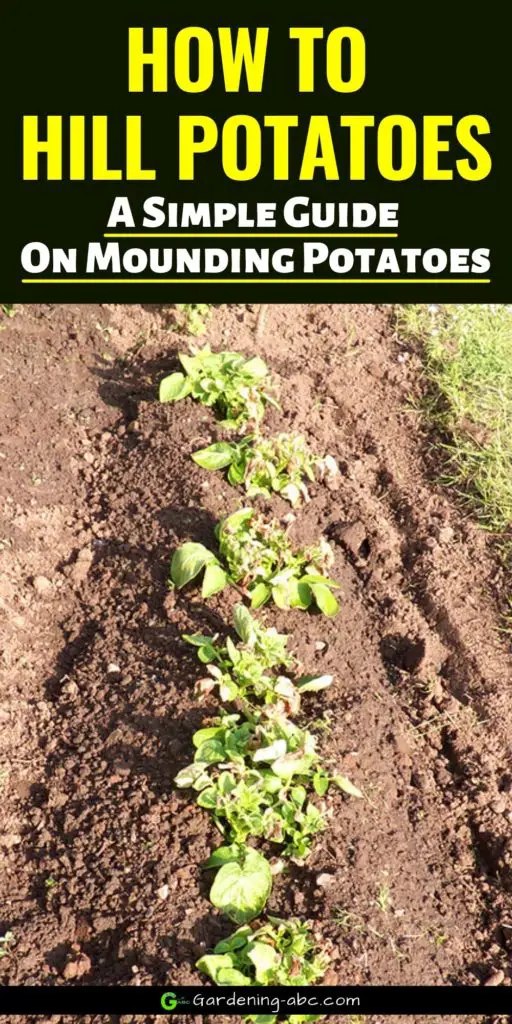We use affiliate links to run our site. When you buy through links on our site, we may earn an affiliate commission, without any added cost to you. Learn more
Are you ready to take your potato-growing game to the next level? If so, you’re in the right place! Hilling potatoes is an essential technique that can help you grow bigger, healthier, and more productive potato plants.
Hilling involves mounding soil around your potato plants to encourage healthy growth and increase yields. But it isn’t just about piling up dirt – there’s a lot more to it than that!
In this comprehensive guide, we’ll take you through all the steps of preparing your soil for hilling, from loosening the soil to removing weeds and adding compost.
With our expert tips, you’ll be able to grow the best potatoes you’ve ever tasted! So grab your gardening tools and let’s get started.
What is Hilling:
The main edible part of a potato plant is the tubers. The tubers are formed along little stems or stolons from a potato plant that is buried underground.
So, no matter how you grow a potato plant you should cover the plant stem periodically with soil or other organic materials. This process is known as hilling of potatoes.
The soil will encourage the plant to grow deep and wide and allow new tuber formation. The more you hill the plant the more potatoes you will have.
Is Potato Hilling Necessary:
Your potato plants will still grow even if you don’t hill them. But If you don’t mound potatoes, you will probably end up with green and bitter potato tubers. This is because potatoes when get exposed to sunlight turn green.
Why You Should Hill Your Potatoes:
Hilling your potatoes, has many benefits for your developing crop, like:
- Higher yield
- Prevents toxicity.
- Kills weeds.
- Prevent the soil from getting too hot.
- Gives stability to the plant

Higher Yields:
Just preparing good healthy soil for your potatoes is not enough for a higher yield. As the potato tubers are formed in underground stems or stolons, by increasing the total number of stolons that are buried you are increasing the opportunity for the plant to grow more tubers.
So generally, The more you hill the more potatoes you get.
Hilling Prevents Toxicity in Potato Plants:
When a potato plant starts forming tubers, it starts at the soil level. If they remain uncovered they will come in contact with the sunlight and will develop green skin. This can cause the tubers to taste bitter and can also be toxic.
So hilling the plant prevents the tubers from getting toxic. Depth and darkness also improve the flavor of potatoes.
Kills Weeds:
Hilling also suppresses weeds and gives your potato plants the opportunity to grow without any competition. The plants won’t thrive if they’re competing with other weeds in the area.
Maintaining The Soil Temperature:
This is very important if you live in warmer climates. Hot soil can prevent a potato plant from developing tubers rapidly.
So by hilling your potatoes, especially with organic materials like straw, you’re actually insulating the soil and keeping it as cool as possible. This will result in a bigger better potato yield.
Provides Stability As Plants Grow Taller :
When you hill up your potatoes constantly you also give your plants support. This way, you won’t have to use stakes or cages to keep them from falling over. it will prevent your potato plants from falling over.
Things to do before you start hilling your potatoes:
Before you start hilling potatoes, you first need to properly prepare the soil. Here is how to do this.
First, loosen the soil with a garden fork or cultivator. This will help prevent damage to the roots and allow for better soil drainage, which is essential for healthy potato growth.
Please be gentle with this. Potatoes have delicate roots that can easily be damaged in the process if you are not careful.
Next, remove any weeds or debris from around the plants. Weeds can compete with potatoes for nutrients, and debris can harbor pests or diseases that can damage your plants. Remove them to give your potatoes the best chance for success.
Finally, add compost or other organic matter to the soil. This can help improve soil fertility and provide additional nutrients for your potato plants.
When to Hill Potatoes:
Once the potato vines reach a height of about 6 to 8 inches above the soil surface, you need to start hilling your potatoes.
Things you Can Use To Hill Your Potatoes:
You can use soil, grass clippings, or weed-free straw to hill your potatoes. Whatever you choose, bring them up over the plants so that only about the top 2 to 6 inches of vines are exposed.
This forces new potatoes to grow under the new mound of soil. When the potato vines again reach 6 to 8 inches above the soil surface, repeat the hilling process.
Do these hilling-ups every two to three weeks to ensure you get the best potatoes possible during the harvest.
How to Hill Up Your Potatoes:
Dig a trench down the middle of a potato bed, it will give you the soil to hill the potatoes. A metal rack or a garden hoe will be very useful to do this job. Cover the soil and that place where your potato tubers are developing, in a way that only the top leaves stick out of the ground.
When you heal your potatoes take some mulch or dirt and bring it up against the potato plant and create a ridge. This way your potatoes will develop in that loose soil while the out layer will remain firm.
If you found mounding soil is too much labor you can also use wood chips, hay, or weed-free straw to do the job.
When to Stop Hilling Up Your Potatoes:
You can hill potatoes till the ridge reaches your desired height. In most cases, a height of 30 cm is enough for getting a good harvest. Repeating the process a total of 2 to 3 times should be enough to reach that height.
But remember, natural factors like rain or wind can erode the hills. This may increase the total number of times you need to mound the plant. So rather than keeping them exposed, you can use wire mesh to hold them up and prevent erosion.
It generally takes 100 to 120 days after planting for potatoes to mature. You can reduce the total time by using sprouted potatoes in planting.
FAQs:
Can I use compost or other materials to hill potatoes?
Yes, you can use compost, straw, or other materials to hill potatoes. However, the soil is the most common and effective material to use.
Do I need to hill all potato varieties?
Most potato varieties benefit from hilling, but some, such as early-maturing varieties, may not require it.
Can I plant potatoes in containers?
Yes, you can grow potatoes in containers, but they may require more frequent watering and fertilization.
How do I know when it’s time to harvest potatoes?
Potatoes should be harvested when the foliage has died back and the skin of the tubers is firm.
Conclusion:
Congratulations! You’ve learned all about how to properly prepare your soil for hilling potatoes.
But remember, hilling is just one part of the potato growing process, and there’s always more to learn. If you’re interested in learning more about growing potatoes or other vegetables, be sure to check out our other articles on this site. We have a wealth of information on gardening, farming, and sustainable living, all designed to help you grow the best possible crops and live a more fulfilling life.
We encourage you to take action! Don’t just read this article and move on – share it with your friends and family who might be interested in growing their own potatoes.
And if you haven’t already, start planning your own potato garden today. Whether you have a large plot of land or just a few pots on your balcony, anyone can grow potatoes with a little time and effort.
Like the post. Don’t forget to PIN IT.

Amazon and the Amazon logo are trademarks of Amazon.com, Inc, or its affiliates.

Hi there! My name is Prasenjit and I’m an avid gardener and someone who has grown a passion for growing plants. From my hands-on experience, I have learned what works and what doesn’t. Here I share everything I have learned.
